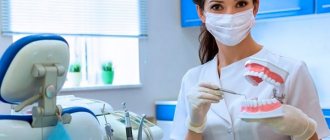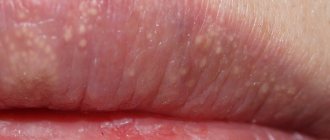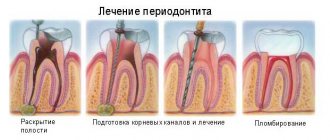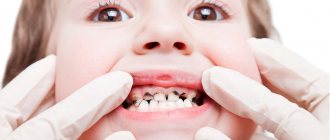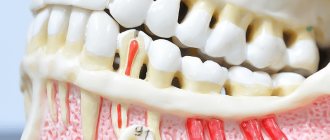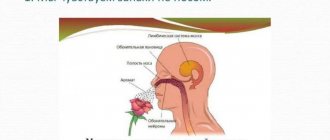Tooth enamel is a durable tissue that is resistant to external influences. But even it can be destroyed. For various reasons, cracks and chips appear on its surface. Cracked teeth are damage that crosses the tooth down towards the root. Damage can also extend under the gum, affecting the pulp chamber and tooth root. The cracked unit does not split into two halves, but the child and pulp are more often damaged.
Due to regular stress, a small crack on the tooth begins to gradually increase. The tooth becomes more sensitive to temperature and reacts to sour and sweet foods. Through microcracks, bacteria enter the tooth and even extend beyond its root, which leads to the development of pulpitis, periodontitis and other serious problems. The most common result of an untreated crack is a split tooth. It will simply break into two fragments and the dentist will have to remove it.
Types of dental cracks
Damage can occur on any area of the enamel; the most dangerous is a split of the tooth root. According to the clinical picture and type of damage, the dentist selects a therapeutic regimen. Types of cracks and their degree of danger:
- Vertical cracks in teeth
are usually shallow, small in size, and affect exclusively the enamel. Usually they do not bother a person and rarely require serious treatment, but they must be closely monitored, since against the background of constant loads, the fracture may increase in size. - Diagonal cracks,
regardless of depth
,
quickly become the main cause of tissue destruction and the appearance of chips and chips on the tooth. Moreover, the destruction affects both the enamel layer, dentin and the pulp chamber. - Horizontal cracks in teeth
pose a similar risk to diagonal fractures and require immediate treatment. It doesn’t matter whether the enamel on the front incisor is cracked or the molar is split across, such damage quickly grows, damaging deep dental tissues. They are the cause of large chips, splitting of the tooth to the top of the root.
If a crack has formed on the surface of the tooth, you should immediately go to the doctor. The lower the degree of damage, the less invasive and costly the intervention will be. Today, dentistry offers a lot of techniques that allow you to “patch” a crack before it causes serious damage, including the loss of a dental unit. But if a microcrack can be eliminated with regular grinding, then if there are chips or a deep split in the tooth, the help of an orthopedist will be required.
Diet
If the mandibular bones are fractured, immediately after the injury the patient is unable to chew. Therefore, he receives exclusively liquid food. Patients are fed through a straw or nasogastric tube.
There are two types of diet recommended for a fracture of the lower jaw:
- first table. It is prescribed for problems with swallowing and chewing food. The recommended calorie intake is 3000 kcal per day. The consistency of the food is similar to heavy cream. The first table provides feeding through a tube;
- second table. It is used if the patient is able to open his mouth. The consistency of the food is similar to thick sour cream.
After the victim is discharged from the medical facility, the following products are recommended:
- vegetable and fruit juices;
- fermented milk products;
- meat broth;
- fruit drinks and compotes.
When preparing food after the patient is discharged from the hospital, a blender is used. This device helps grind food to a liquid consistency.
Symptoms
Small, shallow cracks usually do not show themselves in any way. If the damage is voluminous or located in the root area and puts pressure on the neurovascular bundle, the following symptoms appear:
- Increased sensitivity to temperature and chemical irritants;
- pain when chewing, inhaling cool air;
- swelling of the gums around the damaged tooth;
- formation of chips and chips.
As the symptoms become more severe, the danger of the problem becomes clear. If cracks in the front teeth do not extend beyond the border of the crown, this only affects the aesthetics of the smile line. Increased tooth sensitivity or pain indicate deeper tissue damage.
Diagnosis of a jaw fracture
Identifying injuries to the lower jaw is not particularly difficult. To determine the nature of the damage, a visual inspection and palpation are sufficient. Then the victim is sent for an extensive examination. It allows you to identify complications and functional abnormalities.
Clinical examination
When performing an extraoral examination, swelling and bruising in the affected area are visualized. After this, the doctor begins to palpate the jaw. In this case, the occurrence of pain and a change in the contour are noted.
During intraoral examination, saliva is stained with blood. In this case, a specialist checks the integrity of the teeth and conducts a detailed examination of the oral cavity.
During the clinical examination, the motor activity of the lower jaw is assessed. In this case, the specialist pays attention to how the mouth opens and closes, and the jaw moves forward.
Plain radiography
If there is a crack in the lower jaw, x-rays are taken in different projections. Images are performed in left and right lateral oblique projections. In addition, photographs are taken in an anteroposterior projection. If a fracture of the condylar process is suspected, radiography is additionally performed.
Note! If a fracture is suspected, it is worth taking a survey of the lower and upper jaw. Thanks to this image, it is possible to visualize the bends of the surface in the area of the skull bones.
Orthopantomography
When performing a diagnostic procedure, changes that occur as a result of a violation of the integrity of the lower jaw are visualized. Orthopantomography is quite informative.
Computed tomography CT
This diagnostic method is a combination of computer modeling and x-rays. As a result, it is possible to obtain a clear image of a section of bone structures. The procedure allows you to visualize part of the bone tissue that remains inaccessible during radiography.
Magnetic resonance imaging MRI
MRI involves exposing the scanned area to a constant magnetic field. In this case, electromagnetic pulses quickly penetrate tissue. After reflection, they are sent to sensors, which makes it possible to obtain information about the state of damaged structures. The received information enters the computer system.
Treatment
The treatment method is selected according to the size and depth of the fracture. In one case, artistic restoration is sufficient, in another, prosthetics with a crown may be required.
- In case of microcracks, surface grinding of the enamel is performed, with remineralization, restoration with light-curing material and coating with dental varnish.
- Cracks in the front teeth worsen the aesthetics of the frontal area. Veneering will help restore the beauty of your smile - fixing thin plates of ceramic or composite onto the enamel. The enamel layer is prepared to a depth identical to the thickness of the plate, and a microprosthesis is attached to the prepared surface with dental glue.
- Deep horizontal and vertical splits are restored using dental crowns. Prosthetics with crowns are also carried out if the damage has affected the pulp. After depulping and filling the dental canals, the tooth is given the desired shape (grinded), and an artificial crown is fixed on it.
A tooth split into two halves with a damaged root must be removed followed by prosthetics. Endodontic treatment of cracks in a tooth is possible if the root remains intact. Deep damage to the pulp with extensive spread of the pathological process to the periodontium also leads to removal of the dental unit.
First aid for suspected jaw fracture
If a fracture is suspected, immobilization of the lower jaw with a bandage is necessary. In this case, a hard, even object is placed under the teeth. Then the lower jaw is pressed against the upper jaw and securely fixed with a bandage.
Important! If a fracture of the jaw is suspected, the victim is prohibited from speaking or trying to open his mouth.
In case of loss of consciousness, immobilization is unacceptable (to avoid tongue swallowing and aspiration of vomit). In case of open injury, which is accompanied by bleeding, hemostasis (packing with sterile material) is necessary. To relieve pain and stop bleeding, apply cold to the injured area (for example, a plastic bag with ice). Then the patient’s mouth is freed from vomit and blood clots.
Before emergency personnel arrive, it is worth laying the victim horizontally on his side or ensuring he is in a sitting position. To eliminate severe pain, the patient is given analgesics (Pentalgin, Naproxen). If the victim is unable to swallow the tablet whole, the medicine is crushed to a powder and dissolved in water. If you have painkillers on hand in the form of a solution, it is worth making an intramuscular injection.
Is it possible to avoid the appearance of tooth cracks?
The risk of chipping or other damage to teeth cannot be completely eliminated. But certain precautions can reduce this likelihood:
- Regular hygiene care;
- avoiding excessive chewing loads and injuries;
- use of pastes and brushes recommended by the dentist;
- food high in vitamins, minerals, reduction in sugar and salt in the diet;
- quitting smoking and drinking alcohol;
- avoiding temperature fluctuations while eating or drinking;
- taking multivitamin complexes or calcium supplements with vitamin D;
- using teeth for their intended purpose, and not for opening bottles or biting pencils or nuts.
It is impossible to get rid of cracked teeth without the help of a doctor. Traditional therapy is useless and powerless; you should not put off going to the dentist. Delay will only cause an increase in splitting, destruction of dentin and infection of deep tissues, which can lead to the loss of a dental unit.
What to do if a tooth is cracked
In this case, you need to urgently make an appointment with a dentist. A timely visit to an experienced dentist will increase the chances of saving a cracked tooth and reduce the cost of treatment. Please follow these guidelines before visiting the dental clinic.
- Do not probe the crack with your tongue or touch the tooth with your hands.
- Avoid chewing load on the injured crown.
- Every hour, rinse your mouth with an antiseptic, a decoction of medicinal herbs (chamomile, sage) or a weak saline solution (0.5 tsp per glass of water at room temperature).
These measures will prevent the crack from enlarging and the introduction of infection into the tooth pulp.
Where to carry out preventive measures
Regular dental examinations (at least once a year) will help diagnose the problem at an early stage. When cracks appear, remineralization therapy aimed at strengthening the enamel will help stop further tissue destruction and prevent complications. The doctor will treat the teeth with a composition with a high concentration of fluoride, phosphorus and calcium. Next, the crack is sealed with varnish to strengthen and protect the enamel layer. You can carry out preventive remineralization of enamel in Moscow at the Ilatan clinic.
Prevention of root injuries
The best treatment is disease prevention. To prevent cracks at the root, try to follow a few recommendations:
- be careful and attentive, because half of the cases of root cracks are household injuries, which can be avoided if you take care of yourself and your health;
- carefully choose a clinic and a doctor - before visiting a dentist, check the reviews and ratings of the clinic, certificates and specialist diplomas, do not go to questionable dentists;
- strengthen your teeth - eat healthy foods, do not forget about the importance of calcium and fluoride in strengthening your teeth, choose suitable dental hygiene products.
If symptoms of a root crack occur, do not self-medicate and do not wait for the pain to go away on its own. See your doctor. If the pain is caused by a temporary phenomenon, you will be calm, and if a crack is discovered at the root, treatment at the initial stage will help maintain the health and beauty of your smile, avoid complications and unnecessary expenses.
